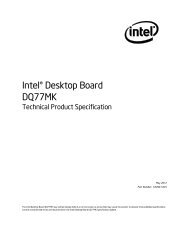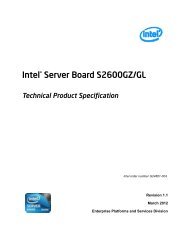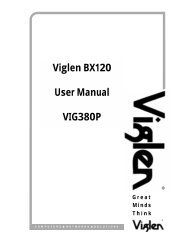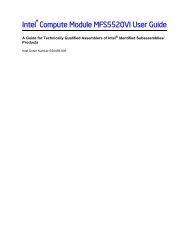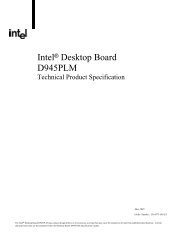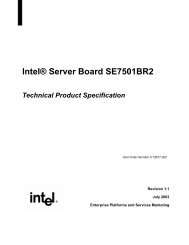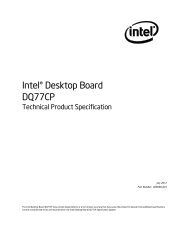- Page 1: Intel ® 631xESB/632xESB I/OControl
- Page 4 and 5: Intel ® 631xESB/632xESB I/O Contro
- Page 8 and 9: 5.20.3 Data Encoding and Bit Stuffi
- Page 10 and 11: 12.1.60 D30IP - Device 30 Interrupt
- Page 12 and 13: 14.1.39 VC0CAP - VC0 Resource Capab
- Page 14 and 15: 15.1.4 PCISTS - PCI Status Register
- Page 17 and 18: 17.1.6 PI - Programming Interface R
- Page 19 and 20: 19.1.19 PCID - Programmable Codec I
- Page 21 and 22: 21.3.1 TCW - Timer Control Word Reg
- Page 23 and 24: 22.1.27 ATS - APM Trapping Register
- Page 25 and 26: 24.2.12 AUX_CTL - Auxiliary Control
- Page 27 and 28: 25.3.1 DID - Device Identification
- Page 29 and 30: 25.5.20 USB_RELNUM - USB Release Nu
- Page 31 and 32: 5-22 USB Legacy Keyboard Flow Diagr
- Page 33 and 34: 5-29 Address Shifting in 16-Bit I/O
- Page 35 and 36: 16-3 Run/Stop, Debug Bit Interactio
- Page 37 and 38: Introduction1 Introduction1.1 About
- Page 39 and 40: IntroductionChapter 9, “Mechanica
- Page 41 and 42: Introduction• Dual Gigabit MAC wi
- Page 43 and 44: IntroductionThe PCI-X interface on
- Page 45: IntroductionAdvanced Programmable I
- Page 49 and 50: Signal Descriptions2 Signal Descrip
- Page 51 and 52: Signal DescriptionsFigure 2-1.Intel
- Page 53 and 54: Signal Descriptions2.1 Enterprise S
- Page 55 and 56: Signal DescriptionsTable 2-5. PCI I
- Page 57 and 58: Signal Descriptions2.4 PCI/PCI-X* B
- Page 59 and 60: Signal Descriptions2.5 PCI/PCI-X* B
- Page 61 and 62: Signal DescriptionsTable 2-10. PCI-
- Page 63 and 64: Signal DescriptionsTable 2-10. PCI-
- Page 65 and 66: Signal DescriptionsTable 2-13. Seri
- Page 67 and 68: Signal Descriptions2.12 LPC Interfa
- Page 69 and 70: Signal DescriptionsTable 2-19. Proc
- Page 71 and 72: Signal DescriptionsTable 2-21. Powe
- Page 73 and 74: Signal Descriptions2.21 RS-232 Inte
- Page 75 and 76: Signal DescriptionsTable 2-29. Gene
- Page 77 and 78: Signal DescriptionsTable 2-30. Misc
- Page 79 and 80: Signal Descriptions2.28 Pin StrapsT
- Page 81 and 82: Signal DescriptionsTable 2-32. Func
- Page 83 and 84: Signal DescriptionsTable 2-33.Intel
- Page 85 and 86: Intel ® 631xESB/632xESB I/O Contro
- Page 87 and 88: Intel ® 631xESB/632xESB I/O Contro
- Page 89 and 90: Intel ® 631xESB/632xESB I/O Contro
- Page 91 and 92: Intel ® 631xESB/632xESB I/O Contro
- Page 93 and 94: Intel ® 631xESB/632xESB I/O Contro
- Page 95 and 96: Intel ® 631xESB/632xESB I/O Contro
- Page 97 and 98:
Intel ® 631xESB/632xESB I/O Contro
- Page 99 and 100:
Intel ® 631xESB/632xESB I/O Contro
- Page 101 and 102:
Functional Description5 Functional
- Page 103 and 104:
Functional Description5.1 PCI Expre
- Page 105 and 106:
Functional Description• On-die te
- Page 107 and 108:
Functional DescriptionTable 5-4.PCI
- Page 109 and 110:
Functional DescriptionA new registe
- Page 111 and 112:
Functional DescriptionTable 5-7. St
- Page 113 and 114:
Functional DescriptionIntel ® 631x
- Page 115 and 116:
Functional DescriptionM66EN Pin Han
- Page 117 and 118:
Functional Description5.1.3.1.2 Ove
- Page 119 and 120:
Functional DescriptionFigure 5-5 is
- Page 121 and 122:
Functional Description5.1.3.1.7 PCI
- Page 123 and 124:
Functional DescriptionIntel ® 631x
- Page 125 and 126:
Functional DescriptionTable 5-12.PC
- Page 127 and 128:
Functional DescriptionIf RCTL.PIE i
- Page 129 and 130:
Functional Description5.2.4.4 SMI/S
- Page 131 and 132:
Functional Description5.3.2.8 Memor
- Page 133 and 134:
Functional Description5.4 Integrate
- Page 135 and 136:
Functional Description5.4.2 Packet
- Page 137 and 138:
Functional DescriptionTable 5-16.St
- Page 139 and 140:
Functional DescriptionTable 5-19. A
- Page 141 and 142:
Functional Description• Reception
- Page 143 and 144:
Functional DescriptionOffset# ofByt
- Page 145 and 146:
Functional Descriptionits link part
- Page 147 and 148:
Functional Description5.4.9.1 Flash
- Page 149 and 150:
Functional DescriptionFigure 5-9.Se
- Page 151 and 152:
Functional DescriptionIn any config
- Page 153 and 154:
Functional Description• External
- Page 155 and 156:
Functional DescriptionBIOS and EFI
- Page 157 and 158:
Functional Description5.5.5.1.5 PCI
- Page 159 and 160:
Functional DescriptionFigure 5-12.
- Page 161 and 162:
Functional DescriptionThe HOST inte
- Page 163 and 164:
Functional Description5.6.1.1 LPC C
- Page 165 and 166:
Functional Description5.6.1.6 SYNC
- Page 167 and 168:
Functional Descriptionany other pur
- Page 169 and 170:
Functional DescriptionThe address s
- Page 171 and 172:
Functional DescriptionThere may be
- Page 173 and 174:
Functional Descriptionarbitrate aft
- Page 175 and 176:
Functional DescriptionTable 5-30.Co
- Page 177 and 178:
Functional DescriptionTable 5-31. I
- Page 179 and 180:
Functional Description5.10.2.1 ICW1
- Page 181 and 182:
Functional Description5.10.4.5 Poll
- Page 183 and 184:
Functional DescriptionInternal sour
- Page 185 and 186:
Functional Description2. Internally
- Page 187 and 188:
Functional Description5.12 Serial I
- Page 189 and 190:
Functional DescriptionTable 5-38. D
- Page 191 and 192:
Functional DescriptionIntel ® 631x
- Page 193 and 194:
Functional Description5.14.1.1 A20M
- Page 195 and 196:
Functional Description5.14.2 Dual-P
- Page 197 and 198:
Functional DescriptionTable 5-43.Ge
- Page 199 and 200:
Functional DescriptionTable 5-46. C
- Page 201 and 202:
Functional Description5.15.5.1 Tran
- Page 203 and 204:
Functional DescriptionIt is importa
- Page 205 and 206:
Functional Descriptionprocessor is
- Page 207 and 208:
Functional Description5.15.8.2 RI#
- Page 209 and 210:
Functional Description3. BIOS conti
- Page 211 and 212:
Functional Description5.15.9.3 Read
- Page 213 and 214:
Functional Description• Signals w
- Page 215 and 216:
Functional Descriptiona. The SMLink
- Page 217 and 218:
Functional Description5.16.1.6 Dete
- Page 219 and 220:
Functional Description8. After step
- Page 221 and 222:
Functional DescriptionTable 5-57. H
- Page 223 and 224:
Functional DescriptionData prefetch
- Page 225 and 226:
Functional Description4. The Bus Ma
- Page 227 and 228:
Functional Descriptioninternal line
- Page 229 and 230:
Functional Description5.18.1.2 48-B
- Page 231 and 232:
Functional DescriptionWhen an opera
- Page 233 and 234:
Functional Description3. Set PxIE.P
- Page 235 and 236:
Functional DescriptionFigure 5-21.
- Page 237 and 238:
Functional Description3. Software s
- Page 239 and 240:
Functional Description5.20.3 Data E
- Page 241 and 242:
Functional Descriptionthe transfer
- Page 243 and 244:
Functional DescriptionTable 5-62.Bi
- Page 245 and 246:
Functional DescriptionTable 5-63.US
- Page 247 and 248:
Functional Description5.21.1.3 EHC
- Page 249 and 250:
Functional Descriptionaccesses main
- Page 251 and 252:
Functional DescriptionThe Port-Rout
- Page 253 and 254:
Functional Descriptionallows commun
- Page 255 and 256:
Functional Description— b. Resets
- Page 257 and 258:
Functional Description5.22 SMBusIf
- Page 259 and 260:
Functional DescriptionSend Byte / R
- Page 261 and 262:
Functional DescriptionTable 5-66.I
- Page 263 and 264:
Functional DescriptionThe 25 ms tim
- Page 265 and 266:
Functional DescriptionIf a Master l
- Page 267 and 268:
Functional DescriptionTable 5-73.Da
- Page 269 and 270:
Functional Description5.22.2 SMBus
- Page 271 and 272:
Functional Description12 bits of ad
- Page 273 and 274:
Functional DescriptionFigure 5-27.
- Page 275 and 276:
Functional DescriptionFigure 5-34.
- Page 277 and 278:
Functional Description.Table 5-78.F
- Page 279 and 280:
Functional Description5.23.2 AC-Lin
- Page 281 and 282:
Functional DescriptionSee your Plat
- Page 283 and 284:
Functional DescriptionFigure 5-39.
- Page 285 and 286:
Functional Descriptionengine moves
- Page 287 and 288:
Electrical Characteristics6 Electri
- Page 289 and 290:
Electrical CharacteristicsTable 6-4
- Page 291 and 292:
Electrical CharacteristicsTable 6-5
- Page 293 and 294:
Electrical CharacteristicsTable 6-7
- Page 295 and 296:
Electrical CharacteristicsFigure 6-
- Page 297 and 298:
Electrical CharacteristicsTable 6-1
- Page 299 and 300:
Electrical Characteristics4. For co
- Page 301 and 302:
Electrical CharacteristicsTable 6-1
- Page 303 and 304:
Component Ballout7 Component Ballou
- Page 305 and 306:
Component BalloutTable 7-2.Intel ®
- Page 307 and 308:
Signal Lists8 Signal Lists8.1 Intel
- Page 309 and 310:
Signal ListsIntel ® 631xESB/632xES
- Page 311 and 312:
Signal ListsIntel ® 631xESB/632xES
- Page 313 and 314:
Signal ListsIntel ® 631xESB/632xES
- Page 315 and 316:
Signal ListsIntel ® 631xESB/632xES
- Page 317 and 318:
Signal ListsIntel ® 631xESB/632xES
- Page 319 and 320:
Signal ListsIntel ® 631xESB/632xES
- Page 321 and 322:
Signal ListsIntel ® 631xESB/632xES
- Page 323 and 324:
Signal Lists8.2 Intel ® 631xESB/63
- Page 325 and 326:
Signal ListsIntel ® 631xESB/632xES
- Page 327 and 328:
Signal ListsIntel ® 631xESB/632xES
- Page 329 and 330:
Signal ListsIntel ® 631xESB/632xES
- Page 331 and 332:
Signal ListsIntel ® 631xESB/632xES
- Page 333 and 334:
Signal ListsIntel ® 631xESB/632xES
- Page 335 and 336:
Signal ListsIntel ® 631xESB/632xES
- Page 337 and 338:
Signal ListsIntel ® 631xESB/632xES
- Page 339 and 340:
Mechanical Specifications9 Mechanic
- Page 341 and 342:
Mechanical SpecificationsFigure 9-4
- Page 343 and 344:
Testability10 Testability10.1 JTAG
- Page 345 and 346:
Testability10.2.1 XOR Chain Testabi
- Page 347 and 348:
TestabilityTable 10-6. XOR Chain #3
- Page 349 and 350:
Testability2Table 10-8. XOR Chain #
- Page 351 and 352:
Register and Memory Mapping11 Regis
- Page 353 and 354:
Register and Memory MappingTable 11
- Page 355 and 356:
Register and Memory MappingTable 11
- Page 357 and 358:
Register and Memory MappingPCI cycl
- Page 359 and 360:
Chipset Configuration Registers12 C
- Page 361 and 362:
Chipset Configuration RegistersTabl
- Page 363 and 364:
Chipset Configuration RegistersBitD
- Page 365 and 366:
Chipset Configuration Registers12.1
- Page 367 and 368:
Chipset Configuration RegistersBitD
- Page 369 and 370:
Chipset Configuration Registers12.1
- Page 371 and 372:
Chipset Configuration Registers12.1
- Page 373 and 374:
Chipset Configuration Registers12.1
- Page 375 and 376:
Chipset Configuration RegistersBitD
- Page 377 and 378:
Chipset Configuration RegistersBitD
- Page 379 and 380:
Chipset Configuration Registers12.1
- Page 381 and 382:
Chipset Configuration Registers00 =
- Page 383 and 384:
Chipset Configuration RegistersBits
- Page 385 and 386:
Chipset Configuration Registers12.1
- Page 387 and 388:
Chipset Configuration Registers12.1
- Page 389 and 390:
Chipset Configuration Registers12.1
- Page 391 and 392:
Chipset Configuration Registers12.1
- Page 393 and 394:
Chipset Configuration Registers12.1
- Page 395 and 396:
Chipset Configuration Registers12.1
- Page 397 and 398:
PCI Express* Bridge, Switch, and En
- Page 399 and 400:
PCI Express* Bridge, Switch, and En
- Page 401 and 402:
PCI Express* Bridge, Switch, and En
- Page 403 and 404:
PCI Express* Bridge, Switch, and En
- Page 405 and 406:
PCI Express* Bridge, Switch, and En
- Page 407 and 408:
PCI Express* Bridge, Switch, and En
- Page 409 and 410:
PCI Express* Bridge, Switch, and En
- Page 411 and 412:
PCI Express* Bridge, Switch, and En
- Page 413 and 414:
PCI Express* Bridge, Switch, and En
- Page 415 and 416:
PCI Express* Bridge, Switch, and En
- Page 417 and 418:
PCI Express* Bridge, Switch, and En
- Page 419 and 420:
PCI Express* Bridge, Switch, and En
- Page 421 and 422:
PCI Express* Bridge, Switch, and En
- Page 423 and 424:
PCI Express* Bridge, Switch, and En
- Page 425 and 426:
PCI Express* Bridge, Switch, and En
- Page 427 and 428:
PCI Express* Bridge, Switch, and En
- Page 429 and 430:
PCI Express* Bridge, Switch, and En
- Page 431 and 432:
PCI Express* Bridge, Switch, and En
- Page 433 and 434:
PCI Express* Bridge, Switch, and En
- Page 435 and 436:
PCI Express* Bridge, Switch, and En
- Page 437 and 438:
PCI Express* Bridge, Switch, and En
- Page 439 and 440:
PCI Express* Bridge, Switch, and En
- Page 441 and 442:
PCI Express* Bridge, Switch, and En
- Page 443 and 444:
PCI Express* Bridge, Switch, and En
- Page 445 and 446:
PCI Express* Bridge, Switch, and En
- Page 447 and 448:
PCI Express* Bridge, Switch, and En
- Page 449 and 450:
PCI Express* Bridge, Switch, and En
- Page 451 and 452:
PCI Express* Bridge, Switch, and En
- Page 453 and 454:
PCI Express* Bridge, Switch, and En
- Page 455 and 456:
PCI Express* Bridge, Switch, and En
- Page 457 and 458:
PCI Express* Bridge, Switch, and En
- Page 459 and 460:
PCI Express* Bridge, Switch, and En
- Page 461 and 462:
PCI Express* Bridge, Switch, and En
- Page 463 and 464:
PCI Express* Bridge, Switch, and En
- Page 465 and 466:
PCI Express* Bridge, Switch, and En
- Page 467 and 468:
PCI Express* Bridge, Switch, and En
- Page 469 and 470:
PCI Express* Bridge, Switch, and En
- Page 471 and 472:
PCI Express* Bridge, Switch, and En
- Page 473 and 474:
PCI Express* Bridge, Switch, and En
- Page 475 and 476:
PCI Express* Bridge, Switch, and En
- Page 477 and 478:
PCI Express* Bridge, Switch, and En
- Page 479 and 480:
PCI Express* Bridge, Switch, and En
- Page 481 and 482:
PCI Express* Bridge, Switch, and En
- Page 483 and 484:
PCI Express* Bridge, Switch, and En
- Page 485 and 486:
PCI Express* Bridge, Switch, and En
- Page 487 and 488:
PCI Express* Bridge, Switch, and En
- Page 489 and 490:
PCI Express* Bridge, Switch, and En
- Page 491 and 492:
PCI Express* Bridge, Switch, and En
- Page 493 and 494:
PCI Express* Bridge, Switch, and En
- Page 495 and 496:
Intel ® High Definition Audio Cont
- Page 497 and 498:
Intel ® High Definition Audio Cont
- Page 499 and 500:
Intel ® High Definition Audio Cont
- Page 501 and 502:
Intel ® High Definition Audio Cont
- Page 503 and 504:
Intel ® High Definition Audio Cont
- Page 505 and 506:
Intel ® High Definition Audio Cont
- Page 507 and 508:
Intel ® High Definition Audio Cont
- Page 509 and 510:
Intel ® High Definition Audio Cont
- Page 511 and 512:
Intel ® High Definition Audio Cont
- Page 513 and 514:
Intel ® High Definition Audio Cont
- Page 515 and 516:
Intel ® High Definition Audio Cont
- Page 517 and 518:
Intel ® High Definition Audio Cont
- Page 519 and 520:
Intel ® High Definition Audio Cont
- Page 521 and 522:
Intel ® High Definition Audio Cont
- Page 523 and 524:
Intel ® High Definition Audio Cont
- Page 525 and 526:
Intel ® High Definition Audio Cont
- Page 527 and 528:
Intel ® High Definition Audio Cont
- Page 529 and 530:
Intel ® High Definition Audio Cont
- Page 531 and 532:
Intel ® High Definition Audio Cont
- Page 533 and 534:
Intel ® High Definition Audio Cont
- Page 535 and 536:
PCI Express* Configuration Register
- Page 537 and 538:
PCI Express* Configuration Register
- Page 539 and 540:
PCI Express* Configuration Register
- Page 541 and 542:
PCI Express* Configuration Register
- Page 543 and 544:
PCI Express* Configuration Register
- Page 545 and 546:
PCI Express* Configuration Register
- Page 547 and 548:
PCI Express* Configuration Register
- Page 549 and 550:
PCI Express* Configuration Register
- Page 551 and 552:
PCI Express* Configuration Register
- Page 553 and 554:
PCI Express* Configuration Register
- Page 555 and 556:
PCI Express* Configuration Register
- Page 557 and 558:
PCI Express* Configuration Register
- Page 559 and 560:
PCI Express* Configuration Register
- Page 561 and 562:
PCI Express* Configuration Register
- Page 563 and 564:
PCI Express* Configuration Register
- Page 565 and 566:
PCI Express* Configuration Register
- Page 567 and 568:
UHCI Controllers Registers16 UHCI C
- Page 569 and 570:
UHCI Controllers Registers16.1.4 PC
- Page 571 and 572:
UHCI Controllers RegistersBitDescri
- Page 573 and 574:
UHCI Controllers Registers16.1.17 U
- Page 575 and 576:
UHCI Controllers Registers16.2 USB
- Page 577 and 578:
UHCI Controllers RegistersTable 16-
- Page 579 and 580:
UHCI Controllers RegistersBitDescri
- Page 581 and 582:
UHCI Controllers RegistersBitDescri
- Page 583 and 584:
EHCI Controller Registers (D29:F7)1
- Page 585 and 586:
EHCI Controller Registers (D29:F7)B
- Page 587 and 588:
EHCI Controller Registers (D29:F7)1
- Page 589 and 590:
EHCI Controller Registers (D29:F7)1
- Page 591 and 592:
EHCI Controller Registers (D29:F7)1
- Page 593 and 594:
EHCI Controller Registers (D29:F7)1
- Page 595 and 596:
EHCI Controller Registers (D29:F7)1
- Page 597 and 598:
EHCI Controller Registers (D29:F7)1
- Page 599 and 600:
EHCI Controller Registers (D29:F7)T
- Page 601 and 602:
EHCI Controller Registers (D29:F7)B
- Page 603 and 604:
EHCI Controller Registers (D29:F7)B
- Page 605 and 606:
EHCI Controller Registers (D29:F7)B
- Page 607 and 608:
EHCI Controller Registers (D29:F7)T
- Page 609 and 610:
EHCI Controller Registers (D29:F7)B
- Page 611 and 612:
EHCI Controller Registers (D29:F7)1
- Page 613 and 614:
PCI-to-PCI Bridge Registers (D30:F0
- Page 615 and 616:
PCI-to-PCI Bridge Registers (D30:F0
- Page 617 and 618:
PCI-to-PCI Bridge Registers (D30:F0
- Page 619 and 620:
PCI-to-PCI Bridge Registers (D30:F0
- Page 621 and 622:
PCI-to-PCI Bridge Registers (D30:F0
- Page 623 and 624:
PCI-to-PCI Bridge Registers (D30:F0
- Page 625 and 626:
PCI-to-PCI Bridge Registers (D30:F0
- Page 627 and 628:
AC’97 Audio Controller Registers
- Page 629 and 630:
AC’97 Audio Controller Registers
- Page 631 and 632:
AC’97 Audio Controller Registers
- Page 633 and 634:
AC’97 Audio Controller Registers
- Page 635 and 636:
AC’97 Audio Controller Registers
- Page 637 and 638:
AC’97 Audio Controller Registers
- Page 639 and 640:
AC’97 Audio Controller Registers
- Page 641 and 642:
AC’97 Audio Controller Registers
- Page 643 and 644:
AC’97 Audio Controller Registers
- Page 645 and 646:
AC’97 Audio Controller Registers
- Page 647 and 648:
AC’97 Audio Controller Registers
- Page 649 and 650:
AC’97 Modem Controller Registers
- Page 651 and 652:
AC’97 Modem Controller Registers
- Page 653 and 654:
AC’97 Modem Controller Registers
- Page 655 and 656:
AC’97 Modem Controller Registers
- Page 657 and 658:
AC’97 Modem Controller Registers
- Page 659 and 660:
AC’97 Modem Controller Registers
- Page 661 and 662:
AC’97 Modem Controller Registers
- Page 663 and 664:
AC’97 Modem Controller Registers
- Page 665 and 666:
LPC Interface Bridge Registers (D31
- Page 667 and 668:
LPC Interface Bridge Registers (D31
- Page 669 and 670:
LPC Interface Bridge Registers (D31
- Page 671 and 672:
LPC Interface Bridge Registers (D31
- Page 673 and 674:
LPC Interface Bridge Registers (D31
- Page 675 and 676:
LPC Interface Bridge Registers (D31
- Page 677 and 678:
LPC Interface Bridge Registers (D31
- Page 679 and 680:
LPC Interface Bridge Registers (D31
- Page 681 and 682:
LPC Interface Bridge Registers (D31
- Page 683 and 684:
LPC Interface Bridge Registers (D31
- Page 685 and 686:
LPC Interface Bridge Registers (D31
- Page 687 and 688:
LPC Interface Bridge Registers (D31
- Page 689 and 690:
LPC Interface Bridge Registers (D31
- Page 691 and 692:
LPC Interface Bridge Registers (D31
- Page 693 and 694:
LPC Interface Bridge Registers (D31
- Page 695 and 696:
LPC Interface Bridge Registers (D31
- Page 697 and 698:
LPC Interface Bridge Registers (D31
- Page 699 and 700:
LPC Interface Bridge Registers (D31
- Page 701 and 702:
LPC Interface Bridge Registers (D31
- Page 703 and 704:
LPC Interface Bridge Registers (D31
- Page 705 and 706:
LPC Interface Bridge Registers (D31
- Page 707 and 708:
LPC Interface Bridge Registers (D31
- Page 709 and 710:
LPC Interface Bridge Registers (D31
- Page 711 and 712:
LPC Interface Bridge Registers (D31
- Page 713 and 714:
LPC Interface Bridge Registers (D31
- Page 715 and 716:
LPC Interface Bridge Registers (D31
- Page 717 and 718:
LPC Interface Bridge Registers (D31
- Page 719 and 720:
LPC Interface Bridge Registers (D31
- Page 721 and 722:
LPC Interface Bridge Registers (D31
- Page 723 and 724:
LPC Interface Bridge Registers (D31
- Page 725 and 726:
LPC Interface Bridge Registers (D31
- Page 727 and 728:
LPC Interface Bridge Registers (D31
- Page 729 and 730:
LPC Interface Bridge Registers (D31
- Page 731 and 732:
LPC Interface Bridge Registers (D31
- Page 733 and 734:
LPC Interface Bridge Registers (D31
- Page 735 and 736:
IDE Controller Registers (D31:F1)22
- Page 737 and 738:
IDE Controller Registers (D31:F1)22
- Page 739 and 740:
IDE Controller Registers (D31:F1)22
- Page 741 and 742:
IDE Controller Registers (D31:F1)22
- Page 743 and 744:
IDE Controller Registers (D31:F1)22
- Page 745 and 746:
IDE Controller Registers (D31:F1)Bi
- Page 747 and 748:
IDE Controller Registers (D31:F1)22
- Page 749 and 750:
SATA Controller Registers (D31:F2)2
- Page 751 and 752:
SATA Controller Registers (D31:F2)2
- Page 753 and 754:
SATA Controller Registers (D31:F2)B
- Page 755 and 756:
SATA Controller Registers (D31:F2)2
- Page 757 and 758:
SATA Controller Registers (D31:F2)2
- Page 759 and 760:
SATA Controller Registers (D31:F2)2
- Page 761 and 762:
SATA Controller Registers (D31:F2)2
- Page 763 and 764:
SATA Controller Registers (D31:F2)2
- Page 765 and 766:
SATA Controller Registers (D31:F2)2
- Page 767 and 768:
SATA Controller Registers (D31:F2)B
- Page 769 and 770:
SATA Controller Registers (D31:F2)B
- Page 771 and 772:
SATA Controller Registers (D31:F2)2
- Page 773 and 774:
SATA Controller Registers (D31:F2)2
- Page 775 and 776:
SATA Controller Registers (D31:F2)B
- Page 777 and 778:
SATA Controller Registers (D31:F2)T
- Page 779 and 780:
SATA Controller Registers (D31:F2)2
- Page 781 and 782:
SATA Controller Registers (D31:F2)B
- Page 783 and 784:
SATA Controller Registers (D31:F2)B
- Page 785 and 786:
SATA Controller Registers (D31:F2)2
- Page 787 and 788:
SATA Controller Registers (D31:F2)2
- Page 789 and 790:
SMBus Controller Registers (D31:F3)
- Page 791 and 792:
SMBus Controller Registers (D31:F3)
- Page 793 and 794:
SMBus Controller Registers (D31:F3)
- Page 795 and 796:
SMBus Controller Registers (D31:F3)
- Page 797 and 798:
SMBus Controller Registers (D31:F3)
- Page 799 and 800:
SMBus Controller Registers (D31:F3)
- Page 801 and 802:
SMBus Controller Registers (D31:F3)
- Page 803 and 804:
LAN Controller and BMC Registers (B
- Page 805 and 806:
LAN Controller and BMC Registers (B
- Page 807 and 808:
LAN Controller and BMC Registers (B
- Page 809 and 810:
LAN Controller and BMC Registers (B
- Page 811 and 812:
LAN Controller and BMC Registers (B
- Page 813 and 814:
LAN Controller and BMC Registers (B
- Page 815 and 816:
LAN Controller and BMC Registers (B
- Page 817 and 818:
LAN Controller and BMC Registers (B
- Page 819 and 820:
LAN Controller and BMC Registers (B
- Page 821 and 822:
LAN Controller and BMC Registers (B
- Page 823 and 824:
LAN Controller and BMC Registers (B
- Page 825 and 826:
LAN Controller and BMC Registers (B
- Page 827 and 828:
LAN Controller and BMC Registers (B
- Page 829 and 830:
LAN Controller and BMC Registers (B
- Page 831 and 832:
LAN Controller and BMC Registers (B
- Page 833 and 834:
LAN Controller and BMC Registers (B
- Page 835 and 836:
LAN Controller and BMC Registers (B
- Page 837 and 838:
LAN Controller and BMC Registers (B
- Page 839 and 840:
LAN Controller and BMC Registers (B
- Page 841 and 842:
LAN Controller and BMC Registers (B
- Page 843 and 844:
LAN Controller and BMC Registers (B
- Page 845 and 846:
LAN Controller and BMC Registers (B
- Page 847 and 848:
LAN Controller and BMC Registers (B
- Page 849 and 850:
LAN Controller and BMC Registers (B
- Page 851 and 852:
LAN Controller and BMC Registers (B
- Page 853 and 854:
LAN Controller and BMC Registers (B
- Page 855 and 856:
LAN Controller and BMC Registers (B
- Page 857 and 858:
LAN Controller and BMC Registers (B
- Page 859 and 860:
LAN Controller and BMC Registers (B
- Page 861 and 862:
LAN Controller and BMC Registers (B
- Page 863 and 864:
LAN Controller and BMC Registers (B
- Page 865 and 866:
LAN Controller and BMC Registers (B
- Page 867 and 868:
LAN Controller and BMC Registers (B
- Page 869 and 870:
LAN Controller and BMC Registers (B
- Page 871 and 872:
LAN Controller and BMC Registers (B
- Page 873 and 874:
LAN Controller and BMC Registers (B
- Page 875 and 876:
LAN Controller and BMC Registers (B
- Page 877 and 878:
LAN Controller and BMC Registers (B
- Page 879 and 880:
LAN Controller and BMC Registers (B
- Page 881 and 882:
LAN Controller and BMC Registers (B
- Page 883 and 884:
LAN Controller and BMC Registers (B
- Page 885 and 886:
LAN Controller and BMC Registers (B
- Page 887 and 888:
LAN Controller and BMC Registers (B
- Page 889 and 890:
LAN Controller and BMC Registers (B
- Page 891 and 892:
LAN Controller and BMC Registers (B
- Page 893 and 894:
LAN Controller and BMC Registers (B
- Page 895 and 896:
LAN Controller and BMC Registers (B
- Page 897 and 898:
High-Precision Event Timer Register
- Page 899 and 900:
High-Precision Event Timer Register
- Page 901 and 902:
High-Precision Event Timer Register




